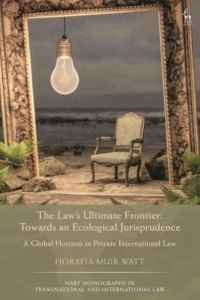Conference report ‘European Account Preservation Order: Practical Challenges and Prospects for Reform’ (University of Luxembourg, 3 December 2024)
This report was written by Carlos Santaló Goris, postdoctoral researcher at the University of Luxembourg
Recent developments on the application of the EAPO Regulation
On 3 December 2024, the conference ‘European Account Preservation Order: Practical Challenges and Prospects for Reform’ took place at the University of Luxembourg, organized by Prof. Gilles Cuniberti (University of Luxembourg). The conference also served as an occasion to present the book ‘European Account Preservation Order – A Multi-jurisdictional Guide with Commentary’, published by Bruylant/Larcier. The book was co-edited by Dr. Nicolas Kyriakides (University of Nicosia), Dr. Heikki A. Huhtamäki (Huhtamäki Brothers Attorneys Ltd), and Dr. Nicholas Mouttotos (University of Bremen), and offers a comprehensive overview on the application of the European Account Preservation Order (‘EAPO’) at the national level. It contains a report for each Member State where the EAPO Regulation applies, addressing specific aspects of the EAPO procedure that depend on domestic law.
The conference was structured into two panel discussions. The first panel focused on the specific issues regarding the application of the EAPO Regulation identified by practitioners with first-hand experience with this instrument. The second panel discussion explored the potential reform of the EAPO Regulation and which specific changes should be implemented to improve its application. This report aims to offer an overview of the main highlights and outputs of the presentations and discussions of the conference.
First panel discussion: the use of the EAPO application in the practice
The first panel was composed of Dr. Laurent Heisten (Moyse & Associates Law Firm, Luxembourg), Alexandra Thépaut (Étude Calvo & Associés, Luxembourg), and Lionel Decotte (SAS Huissiers Réunis, France) and moderated by Dr. Elena Alina Ontanu (University of Tilburg). This first panel aimed to explore specific issues in the application of the EAPO Regulation from the practice perspective. The discussion was opened by Dr. Laurent Heisten, who indicated that the EAPO is way more complex than the Luxembourgish national provisional attachment order, the saisie-arrêt. He highlighted that the Luxembourgish saisie-arrêt has more lenient prerequisites than the EAPO. In his view, that might explain why creditors often opt for the saisie-arrêt instead of the EAPO.
The complexity of the EAPO compared to the Luxembourgish saisie-arrêt was also remarked by Ms. Alexandra Thépaut. However, she also acknowledged that the EAPO presents some advantages against the Luxembourgish national equivalent procedure. In particular, she referred to the certificate that banks have to issue immediately after the implementation of an EAPO (Article 28). This is something that does not occur with the Luxembourgish saisie-arrêt. Another advantage of the EAPO she referred to is the possibility of obtaining information about the debtors’ bank accounts (Article 14). The Luxembourgish saisie-arrêt also lacks an equivalent information mechanism.
During the discussion, Prof. Gilles Cuniberti intervened to indicate that using the EAPO could be less costly than relying on equivalent domestic provisional measures. He refers to a specific case in which the creditor preferred to apply for an EAPO in Luxembourg instead of a domestic provisional attachment order in Germany. The reason was that in Germany, the fee for applying for a national provisional measure would be in proportion to the amount of the claim, while in Luxembourg, there is no fee to obtain an EAPO.
A second recurrent issue identified by the panellists was the use of standard forms. In this regard, Mr. Lionel Decotte highlighted while standard forms can seem practical in a cross-border context, they are rather complicated to fill in. Ms. Alexandra Thépaut mentioned finding particularly complex the section on the interest rates of the EAPO application standard form.
Second panel discussion: the future reform of the EAPO Regulation
The second panel focused on the potential reform of the EAPO Regulation. The panellists were Prof. Gilles Cuniberti, Dr. Carlos Santaló Goris, and Dr. Nicolas Kyriakides, and it was moderated by Dr. Nicholas Mouttotos. Prof. Gilles Cuniberti explored the boundaries of the material scope of the EAPO Regulation. He first advocated suppressing the arbitration exception. He explained that it had been adopted by a political decision which was not submitted to the discussion of the expert group. This was most unfortunate, as the rationale for excluding arbitration from the Brussels I bis and other judgment regulations (the existence of the New York Convention on the Recognition and Enforcement of Foreign Arbitral Awards) was inexistent concerning a remedy belonging to enforcement per se, which was always outside of the scope of the Brussels I bis Regulation.
Prof. Gilles Cuniberti also defended making available the EAPO Regulation in claims regarding matrimonial and succession matters, both expressly excluded from its scope. In his view, there is no reason for these two subject matters to be excluded as the Succession and Matrimonial Property Regimes Regulations, again, only apply to jurisdiction and enforcement of judgments (and choice of law), but do not offer any remedy to attach bank accounts. Lastly, he advocated expanding the use of the EAPO to provisional attachment of financial instruments. This is a potential reform of the EAPO Regulation expressly foreseen in Article 53.
Dr. Carlos Santaló Goris focused on the reform of the EAPO Regulation from the creditors’ perspective. He observed that national case law on the EAPO shows that creditors with an enforceable title encounter many difficulties satisfying the EAPO’s periculum in mora. This is due to the strict interpretation that courts have of this prerequisite in light of Recital 14 of the Preamble. He also mentioned that there is a pending preliminary reference on the interpretation of the EAPO’s periculum in mora before the European Court of Justice (C-198/24, Mr Green).
Regarding the creditor’s security, he stated that the vague criteria used to calculate the amount of the security is also a source of divergences on how the amount of the security is established from one Member State. He provided the example of Germany, where courts often require 100% of the amount of the claim. This percentage contrasts with other Member States, such as Spain, where the amount of the security represents a much lower percentage of the amount of the claim. Additionally, he also suggested reforming the EAPO to transform it into a true enforcement measure. In his view, creditors with an enforceable title should not only have the possibility of obtaining the provisional attachment of the funds in the debtors’ bank accounts but also the garnishment of those funds.
Finally, Dr. Nicolas Kyriakides explored how to foster the use of the EAPO Regulation across the EU. In his view, it would be necessary to expand the use of the EAPO Regulation to purely domestic cases. He referred to the case of the European Small Claims Procedure and how this instrument served as an inspiration for some national legislators to introduce equivalent domestic procedures. In his view, when judges and practitioners use these equivalent domestic procedures, indirectly they become familiar with the EU civil proceedings on which the equivalent domestic procedure was modeled. This is a way of integrating the EU civil proceedings into the legal practice. Therefore, when judges and practitioners have to apply the EU civil procedures, they already know how to do it. This can result in a more efficient and effective application of these EU instruments. On a second level, Dr. Nicolas Kyriakides identified the legal basis that the EU legislator might have to adopt such kinds of measures. He considered that the EU could invoke Article 81 (Judicial cooperation in civil and commercial matters), and Article 114 (Harmonization for the Internal Market) of the Treaty on the Functioning of the European Union could serve to harmonize domestic procedural rules within the boundaries of the principles of subsidiarity, proportionality, and procedural autonomy.
The panelists’ presentations were followed by an open discussion with the audience. One of the issues that was addressed during this discussion was the use of the IBAN to determine the location of the bank accounts. Prof. Gilles Cuniberti expressed his concern about the use of the IBAN since nothing prevents a bank from opening an account with an IBAN that does not correspond to the Member State where the account is effectively held.
Waiting for the Commission’s report on the EAPO Regulation
Following Article 53(1) of the EAPO Regulation, the Commission should have elaborated a report on the application of the EAPO by 18 January 2024. This conference offers a glimpse into what might eventually appear reflected in that report. The EAPO Regulation seems still far from being an instrument often relied on by creditors who try to recover a cross-border claim. The conference, which combined a practical and academic analysis of the EAPO regulation, served to identify some of the problems that might be preventing the EAPO from being perceived by creditors as an efficient tool to secure cross-border claims. Initiatives like this conference can help prepare the ground for designing a more effective EAPO procedure.
 I. Introduction
I. Introduction Horatia Muir Watt (Sciences Po) hardly needs an introduction to the readers of this blog. The
Horatia Muir Watt (Sciences Po) hardly needs an introduction to the readers of this blog. The